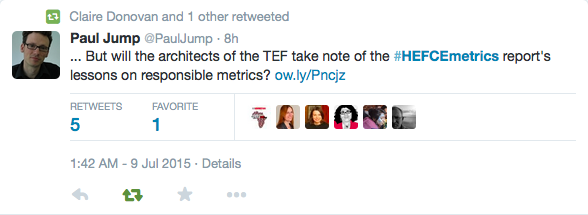Today, the long-awaited ‘Metric Tide’ report from the Independent Review of the Role of Metrics in Research Assessment and Management was published, along with appendices detailing its literature review and correlation studies. The main take-away is: IF you’re going to use metrics, you should use them responsibly (NB NOT: You should use metrics and use them responsibly). The findings and ethos are covered in the Times Higher and summarised in Nature by the Review Chair James Wilsdon, and further comments from Stephen Curry (Review team) and Steven Hill (HEFCE) are published. I highly recommend this response to the findings by David Colquhoun. You can also follow #HEFCEMetrics on Twitter for more snippets of the day. Comments by Cambridge lab head Professor Ottoline Leyser were a particular highlight.
I was asked to give a response to the report at today’s launch event, following up on the significance of mine and Pablo’s widely endorsed submission to the review. I am told that the event was recorded by video and audio so I will add links to that when they show up. But before then, a short summary record of the main points I made:
Read The Whole Report
The executive summary is good, but the whole report is a must-read if you are interested in having a deeper understanding of research culture, management issues and the range of information we have on this field. This should be disseminated and discussed within institutions, disciplines and other sites of research collaboration.
Process
I thought the overall report reflected a very balanced, evidence-led and wide-ranging review process which came to sound conclusions. I don’t say this lightly, having had serious questions about at least one previous policy review process in the sector. And I very much hope that a similar process is employed in terms of bashing out the questions over the mooted Teaching Excellence Framework (on which, no doubt, more posts to come).
I mentioned that although the Review was well-executed, it is not clear that it was necessary to spend the funds on, given the extensive and recent research on the issue. Making policy on a ‘supply-driven’ (because the then Minister had met some altmetric enthusiasts) rather than ‘demand-driven’ (based on what we think we want out of publicly funded research, and where it’s not happening) was a fundamentally misguided way to think about HE policy. We don’t want to keep revisiting questions at the behest of fads or soundbites; rather the best policy should be made with a clear picture (based on evidence, rather than political instinct) of what is actually going wrong or right.
No Metrics-Only Future?
As Colquhoun also notes, there is a key sentence buried on p.131:
“No set of numbers, however broad, is likely to be able to capture the multifaceted and nuanced judgements on the quality of research outputs that the REF process currently provides” (Report, p.131).
So, this is not only a case for waiting for the right indicators to eventually show up, but (as Stephen Curry notes) a sense that many of the things which are good about research are not amenable to capture in indicators based on citations.
This is an extension of the argument made in our previous paper, where we noted that citation-based indicators might indicate something about ‘significance’ but were unlikely to capture either ‘originality’ or ‘rigour’. This particular argument is also compatible with the findings of the Review’s correlational analysis, which showed a generally weak correlation between the results of REF2014 peer review and citation-based indicators.
Responsible Metrics: But Does the UK HE System Allow This To Happen?
In his intervention made directly prior to mine, David Sweeney, Director of Research, Education and Knowledge Exchange at HEFCE, noted that the findings of the review had reflected much of HEFCE’s thinking on the issue and argued that institutions and academics had a free choice in how they used metrics.
For the most part my remarks directly challenged this suggestion that institutions and academics were freely self-governing in the process of research assessment, arguing instead that many structural conditions in the present UK HE system would inhibit the responsible (meaning expert-led, humble, nuanced, supplementing but not substituting careful peer review, reflexive) use of metrics. A non-exhaustive list includes:
- Funding volatility: The attempt to create ‘excellence’ through competition means that universities are now subject to funding volatility, which makes them risk averse. Under such regimes, a reliance on ‘safer’ metric short-cuts is a way for them to manage and re-distribute risk. This is a direct consequence of the ways in which public funding is now delivered to universities in the UK.
- Lay oversight: The role of lay governing bodies and non-academics in managing and overseeing the university produces demands for easy digestible numerical representations of all kinds of research and teaching activity through spreadsheets and benchmarks – in managing funding volatility they are more likely to opt for the prioritisation of numerical indicators over other kinds of judgement.
- Rankings culture: The broader context of a culture driven in all areas by rankings and competition (including VC pay) ideologically prioritises that which can be demonstrated numerically, producing pressures further down the chain for delivery on widely-used metrics
- Non-expert internal review: Amongst colleagues, those without the relevant expertise in the institution to judge the work’s originality, significance and rigour, will tend to default to numerical indicators as a guide if they are increasingly made available to them.
- Time: Everyone in HE is currently pushed for time as we try to manage multiple competing demands and responsibilities, but specific time pressures apply to REF panels, hiring panels and promotion committees.
- Lack of similar experiences by those wielding the judgements: For early career researchers especially, the sense that those who are currently in high positions have not been subject to the same kinds of pressure means that they are making those judgements without a commensurate experience of being judged in that way
These issues come together to create structural conditions in which the ‘responsible use of metrics’ correctly advocated by the Review become highly improbable. The question is, can we change the broader systemic conditions and cultures to allow us to pursue this more responsible approach? And how?


Entirely agree, Meera. HEFCE must be living in lah-lah land if they really think academics are free to choose metrics or not. Maybe Mr Sweeney slept through REF2014, but at my institution and most others, the entire submission process was dominated by attempts to derive every individual researcher’s “Grade Point Average”, with a cut off point for inclusion based on some arbitrary figure that they thought would minimise the risk of research funding being reduced. We have also had metrics-based mass-redundancy processes in the School of Biological and Chemical Sciences, which was widely criticised but ploughed ahead anyway with the loss of 17 academic jobs, and two people who criticised the process were sacked for defying management. It is a myth to think one can simply use metrics or not as you like. Metrics are like any technology – their use is dictated by social relations. The dominance of audit and league tables, driven by competition for funding, is the social context that has driven – and will continue to determine – the use of metrics in HE. The TEF – which is already shaping up to be an utter disgrace – will merely bear this out.
LikeLiked by 1 person
I think you are confusing some issues there Lee. The metrics that Meera the report are referring to are wholly generated in a mechanical way, (H index, IF, etc.),, The GPA, and I’m not defending it, that was generated for each academic in the last REF, wasn’t generated that way, but, at least in the ones I was involved in, through a qualitative assessment of the research. I agree with everything else you say, but it’s important to be clear how data is generated. Data itself isn’t good out bad.
LikeLike
Reblogged this on oshriradhekrishnabole.
LikeLike
I know virtually nothing about metrics, which husbands employer uses. So thanks for the information. It’s not very easy to find.
LikeLike
“No set of numbers, however broad, is likely to be able to capture the multifaceted and nuanced judgements on the quality of research outputs that the REF process currently provides” (Report, p.131).
Hmm. Except that doesn’t the REF process’s peer-review end up with assigning a number of stars from zero to four? A five-state dial doesn’t seem particularly likely to capture multifaceted and nuanced judgements.
LikeLike
Hi Mike – I appreciate that what it produces is a numerical score but you’re missing the point re. the inputs e.g. that reviewers can evaluate different ‘qualities’ e.g. one piece may be very methodologically rigorous and significant, another may be highly original etc. But for other thoughts on shortcomings of REF, see previous post: https://thedisorderofthings.com/2014/06/24/metrics-an-addendum-on-rae-ref/
LikeLike
That post was actually queued up to be my next reading 🙂
I appreciate that the reviewers under the present REF regimen have more freedom take into account non-metric qualities (although I note that they have so very little time to read so many papers that it seems unrealistic to expect them to do a meaningful job of that). But the irony of reducing all that careful expert reading into an score on a scale of zero to four is pretty solid.
BTW., I should say (and should already have said) that I loved your post, and that my own submission to HEFCE’s call for comments was a one-liner and a copy of your PDF. Also, I felt your presentation at the launch event was (along with Ottoline Leyser’s) the best and most realistic. Keep fighting the good fight!
LikeLike
Thanks Mike – much appreciated!
LikeLike
Pingback: Impact of Social Sciences – Can metrics be used responsibly? Structural conditions in Higher Ed push against expert-led, reflexive approach.
Pingback: The Waves of the Metric Tide
Pingback: The waves of The Metric Tide | SAGE Connection – Insight